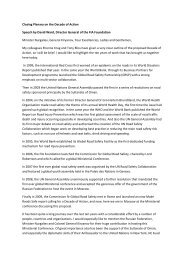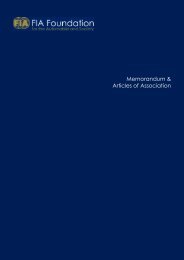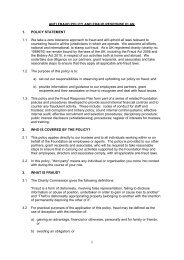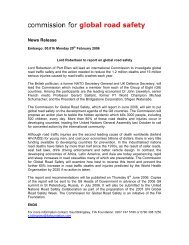Vehicle safety is global - Global NCAP
Vehicle safety is global - Global NCAP
Vehicle safety is global - Global NCAP
Create successful ePaper yourself
Turn your PDF publications into a flip-book with our unique Google optimized e-Paper software.
www.nasva.go.jp<br />
6-1-25 Koji-machi, Chiyoda-ku<br />
Tokyo 102-0083<br />
JAPAN<br />
JARI test facility<br />
Inset: NASVA headquarters<br />
T +81-3-5276-4477<br />
admin@nasva.go.jp<br />
The Japan New Car Assessment Program (J<strong>NCAP</strong>) has been evaluating<br />
the <strong>safety</strong> of vehicles since 1995. The program aims to encourage the<br />
development and widespread use of safer vehicles by providing <strong>safety</strong><br />
information to consumers. It <strong>is</strong> carried out by the Min<strong>is</strong>try of Land, Infrastructure,<br />
Transport, and Tour<strong>is</strong>m and the National Agency for Automotive<br />
Safety and Victims’ Aid (NASVA). Testing <strong>is</strong> conducted at the Japan<br />
Automobile Research Institute.<br />
J<strong>NCAP</strong> releases overall ratings of crash <strong>safety</strong> performance of more<br />
than 100 models, covering more than 80 percent of new vehicles sold<br />
on the Japanese market. Child seat <strong>safety</strong> tests — a frontal coll<strong>is</strong>ion<br />
test and a usability test —have been part of the program since 2001.<br />
Since 2007, NASVA has been awarding the J<strong>NCAP</strong> Grand Prix to the<br />
vehicle model that earns the best ratings among all vehicle models that<br />
were evaluated for the first time in a given year.<br />
CURRENT CRASHWORTHINESS PROGRAMS<br />
J<strong>NCAP</strong> began with full-width frontal tests and braking performance<br />
tests in 1995. A side-impact test was added in 1999, followed by a<br />
frontal offset test the following year. Overall crash performance ratings<br />
have been released since 2000, based on the three crash tests.<br />
The following tests and evaluations are also conducted:<br />
• neck injury (whiplash) mitigation test for rear-end coll<strong>is</strong>ion<br />
performance (since 2009)<br />
• rear seat belt usability evaluation (since 2009)<br />
• passenger seat belt reminder evaluation<br />
• evaluation of rear-seat passenger protection as part of<br />
the frontal offset test (since 2009)<br />
A 2007 analys<strong>is</strong> of crash data showed a correlation between a vehicle’s<br />
J<strong>NCAP</strong> rating and the rate of fatality and seriously injury. Based on th<strong>is</strong><br />
research, it <strong>is</strong> estimated that more than 5,000 fatalities and more than<br />
130,000 serious injuries were prevented from 1995 to 2007 as a result<br />
of J<strong>NCAP</strong>’s work.<br />
FUTURE PLANS<br />
In 2011, J<strong>NCAP</strong> intends to begin testing vehicles for pedestrian leg<br />
protection and for protection against electrical shock after a coll<strong>is</strong>ion.<br />
J<strong>NCAP</strong> also plans to start a new overall rating for <strong>safety</strong> performance<br />
that will combine not only the results of all the crash tests, but also<br />
head and leg pedestrian protection and the seat belt reminder evaluation.<br />
In addition, J<strong>NCAP</strong> <strong>is</strong> studying evaluation methods for crash<br />
avoidance technologies.<br />
• pedestrian head protection performance test (since 2003)<br />
• side curtain airbag evaluation (conducted along with the side<br />
coll<strong>is</strong>ion test since 2008)
















